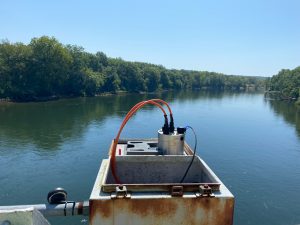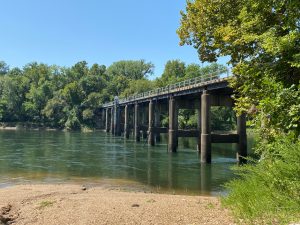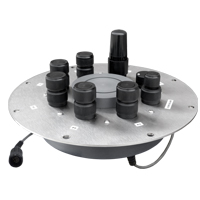 Water is integral to all aspects of life, yet many people neglect to consider where their water comes from. Whether it is used for drinking or recreating, water feeds human and natural resources in the watershed. In order to protect all of the interconnected resources, keeping aquatic systems healthy is necessary, according to Sarah Dexter, an Environmental Program Supervisor with the Oklahoma Water Resources Board (OWRB).
Water is integral to all aspects of life, yet many people neglect to consider where their water comes from. Whether it is used for drinking or recreating, water feeds human and natural resources in the watershed. In order to protect all of the interconnected resources, keeping aquatic systems healthy is necessary, according to Sarah Dexter, an Environmental Program Supervisor with the Oklahoma Water Resources Board (OWRB).
Dexter’s work primarily focuses on monitoring the influence of stormwater in Norman, Oklahoma, as well as overseeing the monitoring of the Grand River Dam Authority’s (GRDA) dissolved oxygen monitoring program. Both programs have the ultimate goal of protecting natural resources from human-caused damages and preventing drastic environmental changes that could reshape surrounding systems.
Challenge: Meeting Environmental and Data Requirements
The main challenge facing the GRDA project was the need to gather data in real-time in order to allow resource managers and dam operators enough time to respond to possible threats to water quality. The system must also be equipped with all of the necessary equipment to quickly and efficiently gather data on the water below the dam.
In order to maintain its operating license, the GRDA must meet Federal Energy Regulatory Commission (FERC) guidelines. The equipment deployed below the dam ensures that dam outputs and the impacted river meet these guidelines. Parameters like dissolved oxygen can change quickly and have devastating impacts on the local aquatic ecosystem—meaning that operators need to make informed decisions quickly.
 In addition to needing water quality monitoring systems that are real-time, the equipment must also be durable for both the dam and river applications. The GRDA project has equipment stationed below the dam, leaving them at the mercy of changing water levels and occasional flooding when runoff occurs.
In addition to needing water quality monitoring systems that are real-time, the equipment must also be durable for both the dam and river applications. The GRDA project has equipment stationed below the dam, leaving them at the mercy of changing water levels and occasional flooding when runoff occurs.
Solution: Durable Equipment for Remote Water Quality Monitoring
In order to meet the real-time needs of the GRDA project, the OWRB, in conjunction with the GRDA, tested various scenarios to create a strategy for monitoring water quality and preemptively mitigate dissolved oxygen declines. The current strategy was adopted in 2013 and included the close monitoring of dissolved oxygen downstream of the dam.
The plan included the deployment of two CB-450s data buoys equipped with X2-CB data loggers stationed below Kerr Dam and three X2 data loggers attached to a bridge downstream of Pensacola Dam to help gather data continuously. Each of the systems gathers data on dissolved oxygen concentrations.
An additional two buoys are stationed in the Horse Creek arm of Grand Lake from May to October when the system experiences lower dissolved oxygen levels. These buoys are also paired with additional sensors that monitor algal blooms.
The data loggers transmit water quality data to the cloud, where Dexter and the GRDA personnel can view the data in real time through the WQData LIVE database. The team of managers and scientists involved in the program all have access to the database where they can view dissolved oxygen conditions in the river.
 Benefits: Early Warning System Mitigates Dissolved Oxygen Declines
Benefits: Early Warning System Mitigates Dissolved Oxygen Declines
The WQData LIVE database is accessible to the many scientists and operators included in the project, making data sharing simple and shortening response times in case levels drop below Oklahoma Water Quality Standards. The shared portal also gives the team access to the alarms that go off and get sent out to everyone involved when dissolved oxygen levels have dropped too low.
There are two alarms designed to sound depending on water quality conditions. The first alarm goes off when dissolved oxygen levels are on the cusp of falling below appropriate levels and alerts operators to release water in order to mitigate further declines and any potential damages. The second alarm occurs only when levels have dropped 1 mg/L below standards and alerts the OWRB, GRDA and other government agencies of current conditions.
The buoys deployed in Horse Creek allow the GRDA scientists to analyze the relationship between blooms and various parameters. Dexter explains, “They put the NexSens buoys out there to try and see if they could catch a bloom happening before it happens. So they’re looking at all these different parameters and their relationships between pH and dissolved oxygen and the chlorophyll and blue green readings and trying to determine if they can catch something happening before it gets too bad.”
 The Bottom Line
The Bottom Line
The OWRB is responsible for many water bodies across Oklahoma, spreading across the state. Having reliable equipment that reports data in real-time saves the board and its scientists time traveling to each monitoring site.
Because water levels below the dam and in the connected rivers and waterways expose the equipment to different environmental conditions, the rugged design of the NexSens buoy keeps data flowing, even in extreme conditions. Dexter expands, “We use a lot of equipment from various companies and NexSens equipment is really sturdy. We’ve had buoys deployed below the dam, during flood conditions, and the buoys are still there! They make it and it’s reliable.”
The data gathered by the OWRB is used to support local operations and initiatives—an important role to fill but sometimes restrictive. “It’s kind of nice to be part of something where maybe there’s not always a tangible solution or sometimes you can see it, like, ‘Okay, this is the solution to this problem—this is how we fix it.’ And sometimes it’s a little frustrating, but it’s nice to be able to think that what we’re doing is part of a process for the greater good and communal use of the data,” Dexter clarifies.
Equipment
The NexSens CB-450 Data Buoy is designed for deployment in lakes, rivers, coastal waters, harbors, estuaries and other freshwater or marine environments.
WQData LIVE is a web-based project management service that allows users 24/7 instant access to data collected from remote telemetry systems.
The NexSens X2 Environmental Data Logger offers the latest in real-time monitoring technology with wireless communication, large plug-and-play sensor library, and ultra-low power consumption.
The X2-CB is a fully featured data logger housed inside a waterproof enclosure specifically designed to integrate with NexSens’ CB-Series data buoys.






